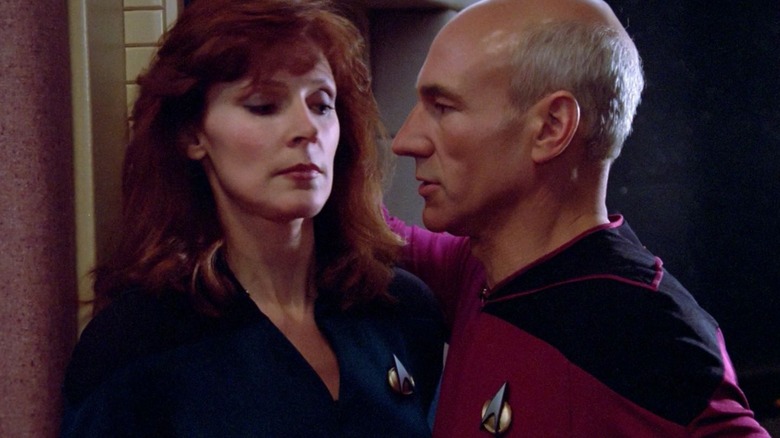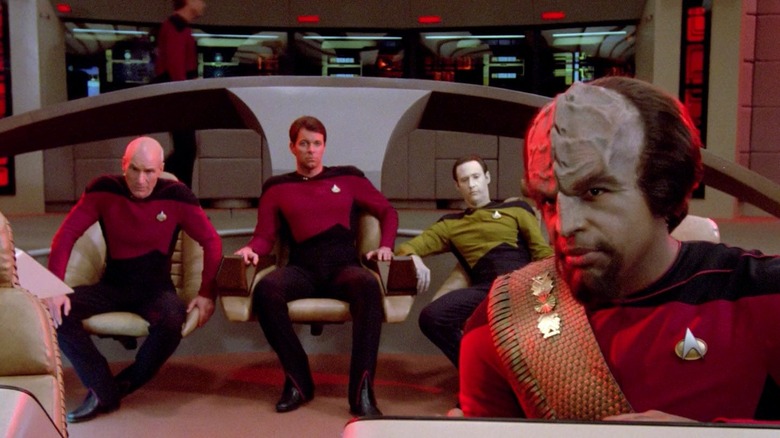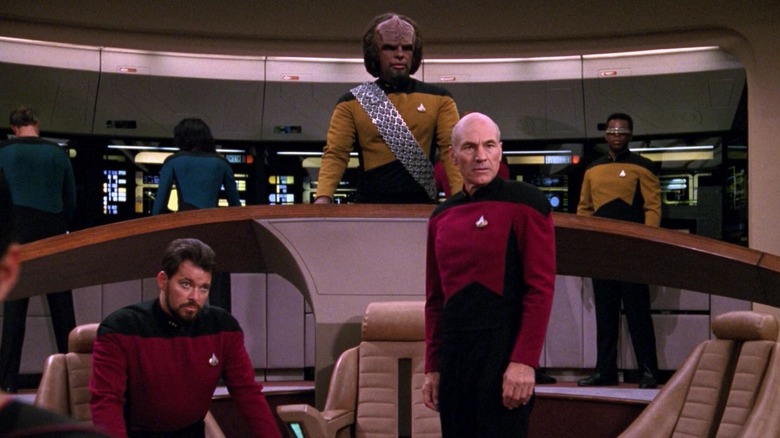Star Trek: TNG's Uniforms Weren't Just Problematic - They Were Disgusting
At the beginning of the third season of "Star Trek: The Next Generation" — a season which debuted on September 25, 1989 — the costumes underwent a noticeable change. In previous seasons, Starfleet uniforms were slim-fitting, one-piece jumpsuits that zipped up the front. If an actor wanted to use the bathroom, they essentially had to strip all the way down. What's more, they were uncomfortable, being so slim-fitting that the actors were forced to walk bolt upright, causing back aches. Jonathan Frakes once said that they also tended to accentuate an actor's gut, which wasn't flattering. And, in addition to all that, most of the actors had to wear fake musculature padding underneath their unitards, making their chests and shoulders slightly broader. It wasn't fun. Those uniforms were designed by William Ware Theiss, who also worked on the costumes on the original "Star Trek."
The changes in season 3 were a relief, as the jumpsuits were abandoned in favor of two-piece uniforms that had shirt and pants sections. The new uniforms were designed by Robert Blackman, who took over the show's costume department in 1989. The new uniforms were a better fit and allowed for a greater range of physical movement. Also, they had little collars now, which was just more aesthetically pleasing. Blackman also upgraded the uniforms' materials, much to the actors' relief. The new uniforms were initially made of wool gaberdine, which was an upgrade from the heavy Lycra spandex of the first two seasons.
Back in 2013, Blackman spoke with the BBC about his career on "Star Trek" (an interview preserved by Fast Company) and he revealed a lot of secrets to the "Star Trek" uniforms that we couldn't see on the screen. Most notably, he said that the Lycra uniforms had poorly designed shoulders, which caused them to pinch up into an actor's armpits. The result was that an actor's armpit stink would soak into the cloth ... and stay there. Lycra notoriously doesn't breathe, and it retained odors. Ew.
Star Trek's Lycra uniforms created quite a stink
Blackman had a litany of complaints about the old spandex uniforms, explaining each issue in detail. He said:
"Jumbo, or Super Spandex, whatever you want to call that heavier weight stretch, will stretch from side to side or top to bottom, depending on how you cut the garment, so the costume would dig into the actors' shoulders, wearing them 12 or 15 hours a day. [...] Spandex is unforgiving, so if you have any sorts of body issues, they are there."
Of course, the costume department dry-cleaned the uniforms regularly, and while the armpit smell might have been sporadically abated, the cleanser stench lingered, which also wasn't pleasant. The smell never interrupted the shooting day, but, according to Blackman, it was definitely noticeable. In his words:
"Spandex retains odor, so there is a certain part where if you're wearing them for a long period of time, you can't really clean all the smell out, and it becomes a little bit annoying. And it also retains the odor of the dry cleaning fluid. It is, on a day-to-day basis, unpleasant."
Blackman's new uniforms debuted on the episode "Evolution," but the wood gabardine, while more comfortable and less stinky, still didn't hang very well. Blackman said that the uniforms continued to undergo several slight redesigns over the course of the season, before finally settling on a steady design about a third of the way in. Patrick Stewart, who played Captain Picard on "Next Generation" famously tugged down the front of his uniform every time he stood up, which was necessary to keep the spandex uniform un-wrinkled. He continued to do so with the new uniforms, however, as the jacket portion would occasionally ride up.
Other problems with the new uniforms
Blackman had an interesting adjective to describe the new unforms, saying:
"At the beginning of that third season, you will see that the uniforms change structure, eventually ending up with an Eisenhower-esque mandarin collar that leaves black yoke and angled color panel on the front, but removes all of the piping, making them essentially, more formal and dignified."
I'm not exactly sure what he means by Eisenhower-esque, as President Eisenhower wasn't necessarily known for wearing unique collars. It's more of a vibe, I think.
Not everyone made the transition to the new uniforms, however. It seems that Gates McFadden, who played Dr. Crusher on "Next Generation," preferred the spandex outfits, liking that they were form-fitting. McFadden began her career as a dancer and choreographer, so she may have been used to Lycra and other tight-fitting costumes that allowed for more dancerly movements. For McFadden, Blackman designed a custom jumpsuit, constructed of a higher-quality stretch material that was made to look like the wool gaberdine that the costumer started the season with. A slight issue arose in the dying process, however. The high-quality cloth retained color a little differently, causing it to be slightly "off" when compared to other blue uniforms in the series.
It's not readily noticeable, but once you see it, you can't unsee it. The problem, however, was corrected in season 5, when McFadden was given new custom uniforms that were more correctly dyed. The cast continued to wear Blackman's Eisenhower-esque designs all the way until the end of the series. The uniforms were then updated for the 1994 feature film "Star Trek: Generations." They've been rapidly evolving ever since.


